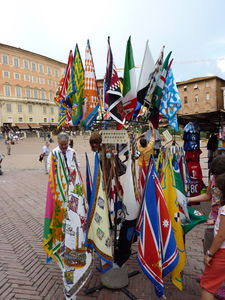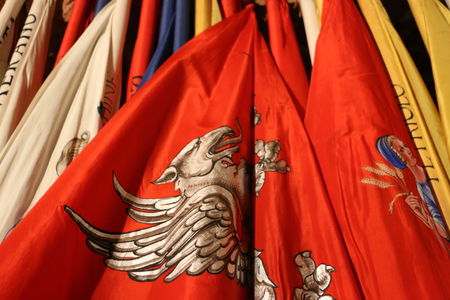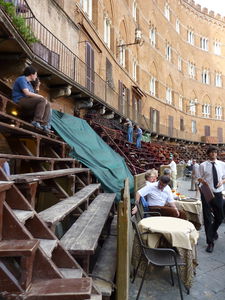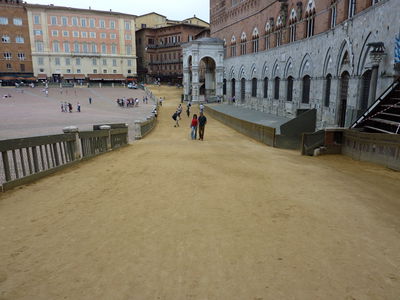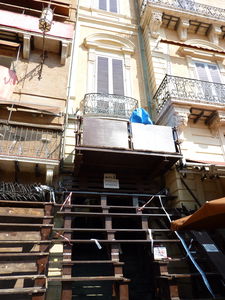It's not just a race, it's a passion
What is the Palio?
The Palio is the most important event in Siena, taking place on July 2 and August 16 every year.
In the Palio, the various Sienese "contrade", or areas in which the city is divided, challenge each other in a passionate horse race in the heart of the city in the Piazza del Campo.
Originally, there were about fifty-nine "Contrade"; now only seventeen remain, ten of which take part in the historical pageant and in the race at each Palio (seven by right and three drawn by lots).
The 17 Contrade which still exist today are: the Eagle, Snail, Wave, Panther, Forest, Tortoise, Owl, Unicorn, Shell, Tower, Ram, Caterpillar, Dragon, Giraffe, Porcupine, She-Wolf and the Goose.
Each Contrada has its own unique emblem and colors and represents an area of the city. As one walks through the streets of Siena it is easy to know in which Contrada you currently are in by observing the flags and emblems displayed along the street. Much like street signs, corners often designate the entrance into a different Contrada with signs as the ones in the picture below.

The Palio horse race has its origins in the distant past, with historical records indicating horse races in Siena already taking place in the 6th century.
The Palio is much more than a simple event for the Sienese, it actually is a large part of their lives since the time of their birth. Each person belongs to a Contrada, participates in the life of the Contrada and the organization of the Palio throughout the entire year. The Sienese live the Palio with great passion and you'll certainly be able to see this if you have the chance to attend one of the races.
The Event
The Palio is a pretty complex event that has gained additional rules through the centuries, as well as traditions and customs, many which only members of the contrada are aware of. Below is a highlight of some of the main rules and traditions of the Palio, which should be useful in better understanding the event.
The Palio horse race takes place twice a year, one the 2nd of July (Palio of Provenzano, in honor of the Madonna of Provenzano) and on August 16th (Palio of the Assumption, in honor of the Virgin Mary's Assumption).
During this special occasion, the main square in Siena, the Piazza del Campo, is prepared for the race as the ring around the square is covered with tuff clay.
Ten out of the seventeen contrade take part in each race: seven are those that did not participate in the previous race on that day, while the other three are drawn by lots.
The Palio actually takes place over 4 days, the race taking place on the fourth day. The first day is for the "Tratta", or the drawing of the lots and assignment of the horses to each of the Contrade. Therefore, each of the Contrade picks their jockey but not the horse; the horses are drawn and only known at this time, just 4 days before the race!

Before the official race there are 6 trial runs or heats, one in the morning and one in the afternoon. The fifth trial, the one run the evening prior to the official Palio, is called the "prova generale" or general trial, while the last which takes place the morning of the main race, is called "provaccia" or bad trial given the little effort the jockeys put into it in order to avoid tiring the horses too much. The jockeys always mount their horses without a saddle.
The Palio prize is called "Drappellone" or large drape, a large painted canvas each year designed and created by a different artist and which the winning contrada displays in their contrada museum.
The day of the Palio
On the day of the Palio race the city is in full turmoil and the entire day is dedicated to the event.
Around 8 a.m., in the chapel next to the Palazzo Comunale, the Bishop celebrates the "Messa del fantino" or mass for the horse jockeys. Shortly after the mass the last trial takes place in Piazza del Campo, the one called "provaccia".
At 10.30 a.m. within the Palazzo Comunale and in the presence of the mayor, the "segnatura dei fantini" takes place. The name of the jockeys are confirmed and cannot be substituted from that point on.
At around 3 p.m. each Contrada performs a blessing ceremony of its horse and afterwards joins in the large parade in historical costume, with over 600 participants, that winds through the city. The parade arrives around 5 p.m. at the Piazza del Campo, and ends by around 6.30-7 p.m. Shortly thereafter the explosion of a firecracker signals the entrance of the horses into the piazza. As the jockeys come out, each one receives a whip made out of ox sinew which they can use to prod their horse or to irrate the other opponents in the race.

The Race: Il Palio
The race starts off in the "Mossa", an area set up on the piazza delimited by two long pieces of thick rope. The "Mossiere" then calls the Contrade in the order in which they were drawn and checks that the assigned positions are respected. The first 9 Contrade take up their assigned positions in the area between the two ropes, while the last one, the tenth, enters this area at a running gallop thus signaling the start of the race. This only happens when this last Contrada decides to make the attempt to start off the race.
If the start is not considered valid (this is the case if the jockeys are not in their assigned spots), a shot goes out to signal the jockeys to get back into place. This starting phase within the "Mossa" is more complicated than it seems, as the space is small and the horses are right next to each other. Rivalries run deep within the Contrade and competition is high and the worst result is to see the "enemy" Contrada win the race. The wait for the start of the race can thus be extremely long and last into twilight.
If all goes well the start of the race can start at any time. The horses must run three laps around the Campo, overcoming dangerous points such as the very narrow curve of San Martino where collisions between the wall and between horses have led to many falls in the past (the main reason why many animal activists oppose the Palio).
The first horse that crosses the finish line, even if he arrives without his jockey, wins the race. The winning Contrada receives the Drappellone, as the victorious Contrada members head towards the Church of Provenza (after the July race) or towards the Duomo (after the August race) for the "Te Deum" or prayer of thanks.

Our suggestions and tips
The Palio represents without a doubt a unique opportunity to live the warmth and passion of the city of Siena. If you have the opportunity of attending, do not pass up on this chance to experience such a passionate and special celebration.
It is possible to attend the race for free from the center of the Piazza del Campo. We suggest you arrive at least by 4.30 p.m. if you want to try to find enough space to enter into the piazza but earlier is better (if you want a prime location along the side of the race track, these spots are taken by morning, particularly those near the Mossa and the Gaia Fountain and people stake out their spot all day!). Keep in mind: drinks are sold within the piazza but there are no public toilets. We recommend taking your own water bottles and drinks and at least a baseball cap to protect yourself from the sun and heat. Given the large amount of people that get packed into the piazza and the heat, we highly advise against taking small children into the piazza to attend the event, especially as having them on shoulders to let them see (and to avoid squashing them) is not appreciated by all those around you wanting to be able to see the race.
More comfortable positions from which to watch the Palio exist around the Piazza and prices vary for those spots. To buy your tickets in the bleachers or on the balconies that face onto the Piazza, try contacting the APT in Siena to find out more information or try directly contacting the residents of the homes facing the piazza. These often also offer refreshments that include typical Sienese sweets. Lately, some agencies have organized packages to offer the Palio experience and include drinks and the view.
Read here for some insider tips on how to best enjoy the entire Palio experience.
If you're arriving to Siena with a car, check out our page on where to park in Siena; if you're arriving by train or bus, check out how to get to Siena without a car.
Enjoy living the unique atmosphere that only the Palio of Siena offers!
